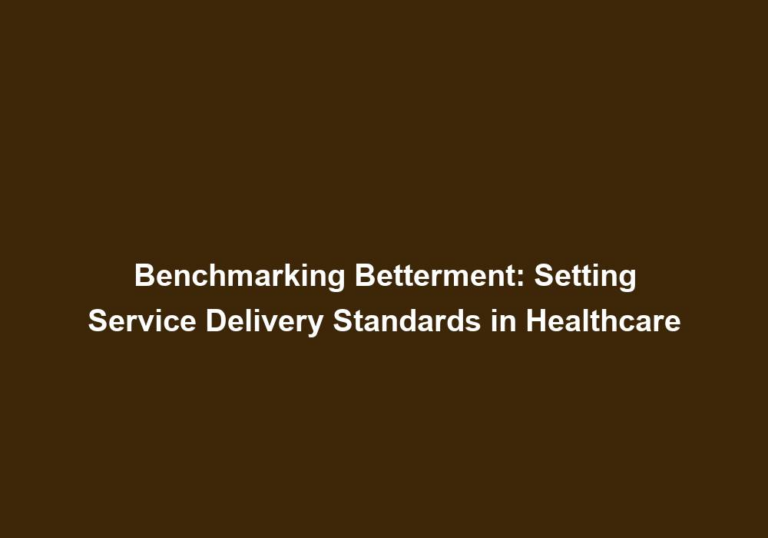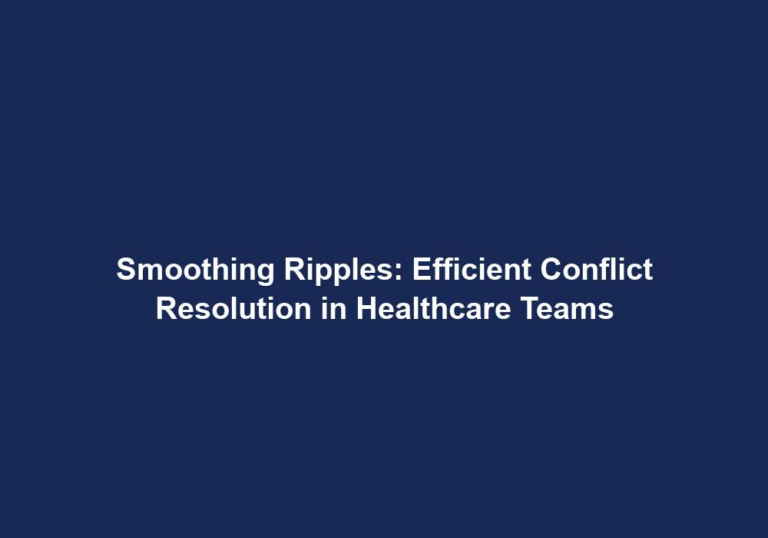Tech-Transformed Care: Best Practices for Implementing Tech in Healthcare
In today’s rapidly evolving world, technology has become an integral part of every industry, including healthcare. The integration of technology in healthcare has revolutionized patient care, improved efficiency, and enhanced outcomes. However, implementing tech in healthcare requires careful planning, consideration, and adherence to best practices to ensure its successful integration and utilization. In this article, we will explore the best practices for implementing technology in healthcare and how it can transform patient care.
Understanding the Need for Tech-Transformed Care
Before diving into the implementation process, it is crucial to understand why tech-transformed care is necessary in the first place. The healthcare industry faces numerous challenges such as rising costs, limited resources, and a growing aging population. Technology can help address these challenges by streamlining processes, enhancing communication, and improving access to care. It has the potential to optimize healthcare delivery, empower patients, and ultimately improve health outcomes.
To fully leverage the benefits of technology in healthcare, organizations must develop a comprehensive implementation strategy that encompasses various aspects of the implementation process.
Developing a Comprehensive Implementation Strategy
Here are some essential steps to consider:
1. Conduct a Needs Assessment
Before implementing any technology, it is crucial to assess the specific needs and challenges faced by the healthcare organization. This assessment should involve input from all stakeholders, including healthcare providers, administrators, and patients. By understanding the current workflow, pain points, and desired outcomes, organizations can identify the most suitable technologies to address their unique needs.
During the needs assessment, it is important to consider factors such as:
- The organization’s goals and objectives
- The specific areas of improvement required
- The potential impact on patient care and outcomes
2. Set Clear Goals and Objectives
Once the needs assessment is complete, it is essential to set clear goals and objectives for the implementation. These goals should be specific, measurable, achievable, relevant, and time-bound (SMART). Clear goals provide a roadmap for the implementation process and help measure its success.
For example, a goal might be to reduce patient wait times by 20% within six months of implementing a new telemedicine platform. This goal provides a clear target and timeline for the implementation team to work towards.
3. Involve All Stakeholders
Successful implementation of technology in healthcare requires the involvement and buy-in of all stakeholders. This includes healthcare providers, administrators, IT staff, and even patients. By involving all parties from the beginning, organizations can ensure that the technology meets the needs of all users and that potential barriers to adoption are addressed early on.
During this stage, it is important to:
- Identify key stakeholders and their roles in the implementation process
- Communicate the benefits and goals of the technology implementation
- Address any concerns or resistance to change
- Encourage active participation and collaboration among stakeholders
4. Choose the Right Technology
Selecting the right technology is crucial for a successful implementation. Healthcare organizations must consider factors such as compatibility with existing systems, ease of use, scalability, and vendor support. Conducting thorough research, seeking recommendations, and even piloting the technology before full-scale implementation can help identify the most suitable solution for the organization’s unique needs.
When choosing the right technology, organizations should:
- Consider the specific needs identified during the needs assessment
- Evaluate the technology’s features and functionalities
- Assess its compatibility with existing systems and infrastructure
- Seek input from end-users, such as healthcare providers and staff
5. Train and Support Users
Once the technology is selected, comprehensive training and support for users are vital. Healthcare providers and staff need to be proficient in using the technology to maximize its benefits. Consider providing training sessions, resources, and ongoing support to ensure that users feel confident and comfortable incorporating the technology into their daily workflows.
During the training and support phase:
- Develop training materials and resources that are easy to understand and accessible
- Provide hands-on training sessions and opportunities for practice
- Offer ongoing support through helpdesks, FAQs, and user forums
- Encourage feedback and address any user concerns or challenges
6. Address Security and Privacy Concerns
With the integration of technology comes the need to address security and privacy concerns. Healthcare organizations must ensure compliance with applicable data protection regulations and implement robust security measures to safeguard patient information. This includes encryption, access controls, regular audits, and staff education on data privacy best practices.
To address security and privacy concerns:
- Implement strong authentication measures to control access to sensitive data
- Regularly update security protocols and systems
- Educate staff on the importance of data privacy and the potential risks associated with technology use
- Establish a clear incident response plan to handle any security breaches or data breaches
7. Monitor and Evaluate the Implementation
Once the technology is implemented, ongoing monitoring and evaluation are essential to measure its impact and identify areas for improvement. Regular feedback from users, data analysis, and performance metrics can help identify any issues or gaps in the implementation process. By continuously assessing the technology’s effectiveness, organizations can make necessary adjustments and optimize its usage to achieve desired outcomes.
During the monitoring and evaluation phase:
- Collect and analyze data on key performance indicators (KPIs) related to the implementation goals
- Seek feedback from users through surveys, interviews, or focus groups
- Identify any challenges or issues faced by users and address them promptly
- Continuously communicate the progress and success of the implementation to stakeholders
Benefits of Tech-Transformed Care
Implementing technology in healthcare brings a multitude of benefits for both healthcare providers and patients. Here are some key advantages:
- Enhanced Efficiency: Technology streamlines processes, automates routine tasks, and reduces administrative burdens, allowing healthcare providers to focus more on patient care.
- Improved Communication: Electronic health records, telemedicine platforms, and secure messaging systems facilitate seamless communication and collaboration among healthcare providers, leading to better-coordinated care.
- Enhanced Access to Care: Telemedicine and remote monitoring technologies enable patients, especially those in rural or underserved areas, to access healthcare services conveniently and receive timely medical attention.
- Personalized Care: Technology enables the collection and analysis of vast amounts of patient data, enabling healthcare providers to deliver personalized treatment plans and interventions tailored to each individual’s needs.
- Patient Empowerment: By providing patients with access to their health information, educational resources, and remote monitoring tools, technology empowers patients to actively participate in their own care, leading to better health outcomes.
Conclusion
The integration of technology in healthcare holds immense potential to transform patient care, improve outcomes, and optimize healthcare delivery. By following the best practices outlined in this article, healthcare organizations can navigate the implementation process successfully and leverage technology to its fullest potential. With careful planning, stakeholder involvement, and continuous evaluation, tech-transformed care can become a reality, revolutionizing the way healthcare is practiced and experienced.







